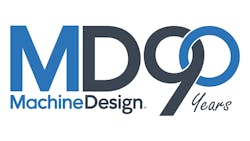As part of Machine Design’s 90th anniversary issue in January, we’ve asked industry experts to take a look at the present and future of technology and how it will impact the design and operation of manufacturing over the next decade.
Q: What is the opportunity in cobots today? Why should design engineers embrace them?
Joe Campbell: Deploying cobot technology is all about lowering the automation barrier and the initial fear of robotic integration. By simplifying the user interface and offering free training and offline simulation, design engineers are able to deploy faster and easier, realizing a quick ROI.
Q: What are common features and trends you are noticing in robotics today?
Campbell: The ability to do free robot programming and training even before the cobot arrives frees up an incredible amount of resources, both in terms of manpower, install budget, and cobot utilization.
Q: What are the challenges the industry faces? Campbell: The biggest challenge is education—showing the broad manufacturing market that automation is becoming very cost-effective, quick to deploy, with great returns on investment. Part of that challenge is the transition to incremental automation.
Traditional automation, rooted in the automotive industry, has been an all-or-nothing proposition: Either automate every step in the entire process, or the project can’t succeed. This approach naturally leads to large investments, long project timelines, high risk, and staff disruption.
Universal Robots believes in the incremental approach to automation: Target the 3 Ds of manufacturing (Dull, Dirty, Dangerous) with collaborative robots and let the skilled operators handle the higher value and more difficult tasks. This approach controls costs, generates ROI very quickly (usually in a matter of months), and leverages the best of human and robot operators.
Q: What are some of the fundamental changes that we’ve already seen?
Campbell: The overall flexibility and ease of setup and programming of the UR collaborative robots has started a fundamental change in how manufacturing departments view robots. Traditional automation required dedicated installations—hard-bolted to the concrete floor, enclosed in safety fencing, programmed by specialists.
Cobots are now routinely being viewed as a manufacturing tool that can easily be moved on a manual cart or frame from machine to machine, process to process, quickly set up and redeployed as production changes. This is allowing high-mix/low-volume operations that previously had no hope of automating to deploy collaborative robots in their day-to-day operations.
Q: What’s the biggest challenge the industry faces in the next decade?
Campbell: The biggest hurdle is filling the labor skills gap to keep up production levels. With the record low unemployment rates, we’re seeing companies consider automation more than ever before, but it’s not because they’re trying to replace humans—they simply can’t find them.
In fact, when the National Association of Manufacturers issued its Outlook Survey last year, it confirmed that finding skilled workers remains one of the top challenges for manufacturing executives today. The Society of Manufacturing Engineers reports that 89% of manufacturers were having difficulty finding skilled workers
And unfortunately the situation does not appear ready to improve anytime soon with 10,000 Baby Boomers retiring every day and Millennials not interested in joining the manufacturing industry. Asked how they were addressing the skills shortage, manufacturing executives’ responses ranged from assigning more overtime (70.3%), relying more on temporary staffing services (57.7%), and encouraging possible retirees to stay longer in their roles (30.7%). These are all strategies that adversely impact the bottom line. And, an additional 28.8% reported they had to turn away new business or had lost revenue opportunities because of workforce constraints.
Q: What’s the solution?
Campbell: Start investing in cobots now in order to prepare production for Baby Boomers retiring with no Millennials joining the manufacturing workforce.
About the Author

Bob Vavra
Editor Emeritus, Machine Design and Power & Motion
Bob Vavra is the former senior content director of Machine Design and Power & Motion.

